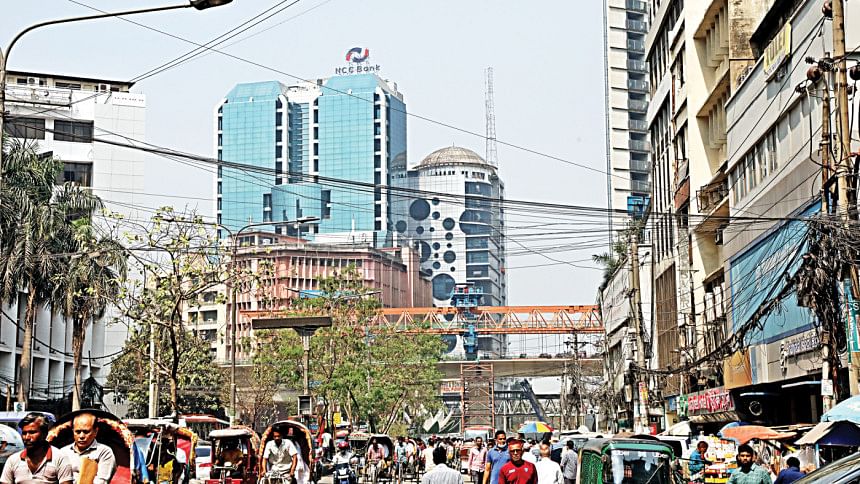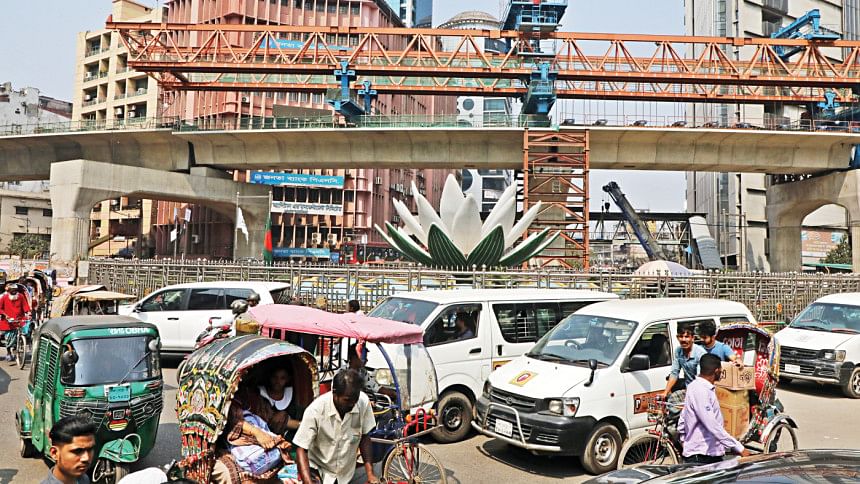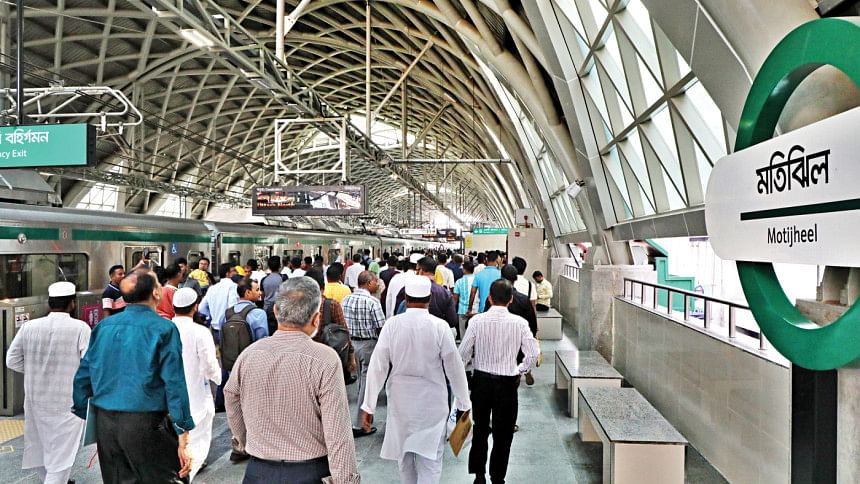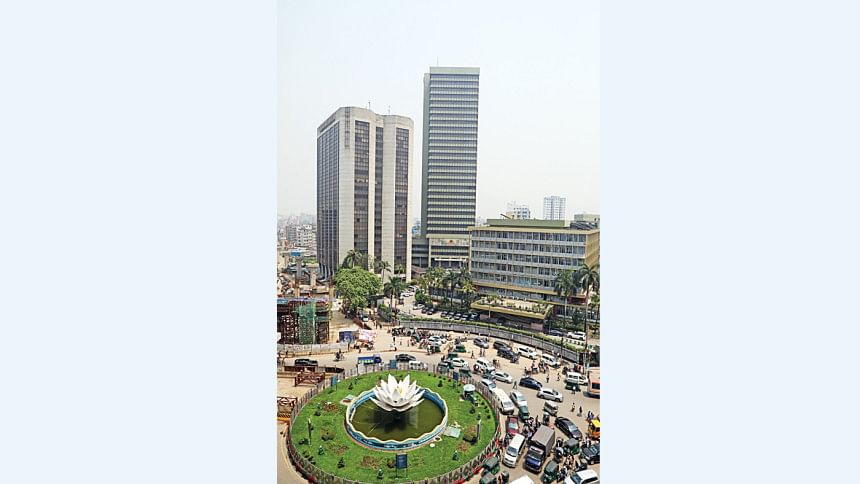Shifting commercial tides: What’s Next for Motijheel?

Motijheel, once a thriving commercial hub in Dhaka, has recently lost its prominence as businesses increasingly shift towards Gulshan and Banani. This trend is particularly evident in the real estate sector, where investment in commercial spaces in Motijheel has declined, largely due to accessibility challenges, daily commuting difficulties from other parts of the city, worsening traffic congestion, pollution, and a lack of pedestrian-friendly infrastructure. However, with the introduction of the metro rail, efforts are underway to restore Motijheel's status as a key business district.
During the Pakistan period, Motijheel gradually emerged as Dhaka's primary commercial district. After independence, it quickly expanded into the city's leading business hub, hosting the head offices of major industrial establishments, particularly banks concentrated in the Motijheel-Dilkusha area, which became widely known as Bank Para. With a high concentration of financial institutions, insurance companies, and brokerage firms, Motijheel thrived as the city's most dynamic commercial zone. However, in recent years, many private banks have relocated their headquarters to Gulshan, gradually eroding Motijheel's status as Dhaka's financial center.

Mohammad Ali, Managing Director & CEO of Pubali Bank, explains the current state of the Motijheel area, noting, "Motijheel is gradually declining. At one time, the rent per square foot in this area was 150 Taka, but it has now dropped to 70 or 80 Taka, with some spaces renting for even less than 50 Taka per square foot. When the heart of the financial street sees rents fall by up to 50 percent due to the departure of many financial companies, the overall transaction volume inevitably declines."
He also shared their future plans, stating that while they are exploring operational space in Gulshan, Pubali Bank's head office will remain in its current building in the Motijheel-Dilkusha area as long as Bangladesh Bank's head office remains there.

"In Motijheel, the extent of building renovations is limited due to decreased demand from private companies. When significant changes are made in any zone, reverting to older forms becomes challenging. This is not dependent on any single individual but rather on funding, intent, and proper planning. Furthermore, the city corporation's efforts in maintaining clean roads, proper lighting, and overall upkeep have been inadequate, reflecting a failure on their part in keeping Motijheel an attractive area," says Md. Wahiduzzaman, President of REHAB.
Urban planners and experts believe that Motijheel has lost its significance due to a lack of proper city planning. As a result, it has suffered for years, ultimately losing its appeal.

Dr. Adil Mohammed Khan, a faculty member at the Urban and Regional Planning Department of Jahangirnagar University, says, "The rise and fall of a city is common. Unfortunately, Motijheel was not developed as a CPD zone (Commercial Planned Development Zone); instead, it is overwhelmingly populated by street hawkers, leaving no space for pedestrians. Even the current business zones in Gulshan were initially planned as residential areas, which were later converted into commercial zones. As a result, their importance gradually increased, and it has now become a new urban center."
Despite being located in a prime area surrounded by key government establishments, many of which are directly involved in commerce and industry, Motijheel has seen a decline. Due to communication challenges and heavy traffic congestion, many important commercial offices have gradually relocated elsewhere.
"Motijheel is the oldest and most vibrant commercial area in Dhaka. This is largely because key commercial centers are located near the Ministry of Commerce, the National Board of Revenue (NBR), and the Secretariat. Additionally, most major banks had their head offices in Motijheel. However, the area's decline was driven by congestion and an unplanned parking system. Now, efforts are being made to address this issue, with dedicated parking buildings like City Center and a city corporation facility where five floors are exclusively designated for parking," says M. Hoque Faishal, Director of Sales, Marketing, CSD & Land at Tropical Homes Ltd.
Apart from communication issues, Motijheel's decline in popularity as a commercial hub can be attributed to other factors related to its surrounding areas, which need to be considered in the context of urban planning. Realtor insiders suggest that areas like Gulshan and Dhanmondi have a favourable mix of both residential and commercial spaces, making them more appealing. In contrast, Motijheel lacks the surrounding residential facilities, leading to its decline as a desirable location for businesses.

According to Mehedi Hasan, Chief Design Coordinator of Credence Housing Ltd., "Urban planning typically develops commercial areas alongside residential zones. Where residential areas are more developed, they also attract commercial investments. However, Motijheel lacks high-standard residential facilities that meet the living standards of high-level business professionals or educated individuals. As a result, MDs, CEOs, and other senior officials prefer to relocate their offices to places like Gulshan or Dhanmondi to avoid the daily commute to Motijheel. Despite offering lower rental prices, Motijheel struggles to attract tenants for commercial spaces, especially compared to the higher-demand areas.''
However, despite the lack of residential facilities in Motijheel, modest housing is expanding in its surrounding neighbourhoods, drawing increasing interest from realtors.
"We have a residential project in Golapbag, near the Motijheel area, which is nearly sold out. However, we don't have any commercial projects in the Motijheel area, as most of the prominent corporate offices have relocated to Gulshan or Banani," shares A.Z.M. Tanvir Ahad, Head of Sales and Marketing at Anwar Landmark Ltd.
Meanwhile, Mehedi Hasan mentions that Credence is currently developing a residential project on a 27.22-katha plot of land on RK Mission Road, which will feature 64 apartment units.
However, Motijheel is gradually regaining its significance as a commercial hub in a new way. Development is expanding in the surrounding areas, particularly with the establishment of many Export Processing Zones (EPZs) along the Dhaka-Chattogram highway and Adamjee EPZ, attracting significant investments. The Padma Bridge has also played a crucial role in facilitating the growth of new industrial and commercial spaces near Motijheel.
As a result, real estate insiders believe that Motijheel will once again draw attention as a key commercial center. Moreover, the presence of the central bank, along with the head offices of several national and some private banks, will further strengthen investor confidence.
"We are constructing a 21-storey building in Fakirapul, equipped with the latest advanced facilities. Additionally, the tallest building in the country, TA Tower, is currently under construction in Malibagh. This landmark commercial project will offer state-of-the-art facilities, and its strategic location ensures that Motijheel can be reached within just 20 minutes. Currently, we have five projects in the Motijheel vicinity—four commercial and one residential," adds M. Hoque Faishal of Tropical Homes Ltd.
"People were initially drawn to Gulshan and Banani due to the traffic congestion in Motijheel, which was primarily a communication issue. However, this has changed with the introduction of the metro rail, which has been a significant blessing for the area. Key commercial hubs in Old Dhaka are still used for transactions in Motijheel, offering a chance for it to regain its former glory," notes Rony Datta, AGM Sales at Building for Future Ltd.

He further mentions that Building for Future Ltd. is currently working on a 25-storey commercial project called Lilypond Center on RK Mission Road. The center houses several financial and international institutions, along with a food court where many renowned industrial ventures are operational.
Concerned stakeholders believe the government plays a crucial role in ensuring Motijheel remains a viable commercial hub and supporting its future development. As Dhaka continues to expand, Motijheel is expected to regain significance, particularly after the completion of the Padma Bridge, solidifying its role as the main commercial center of southern Dhaka.
"Although government buildings are managed by their respective authorities, the city corporation could at least issue notices for annual painting and maintenance, as funds for upkeep are available. Once government establishments showcase their presence and brightness, private companies may show interest again in Motijheel," further mentions Md. Wahiduzzaman, President of REHAB.
"While Gulshan may currently enjoy the status of one of the most attractive commercial hubs with modern facilities, this doesn't mean Motijheel will lose its importance. The government needs to address this, as there are still numerous commercial centers in the area, including informal establishments and unregulated transactions, as well as issues like random car parking. With the Metro Rail already bringing a new attraction to Motijheel, there is potential for the development of more planned public spaces in the area," adds Dr. Adil Mohammed Khan.

 For all latest news, follow The Daily Star's Google News channel.
For all latest news, follow The Daily Star's Google News channel. 



Comments